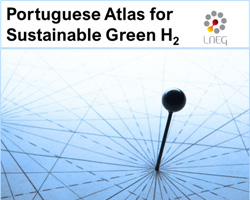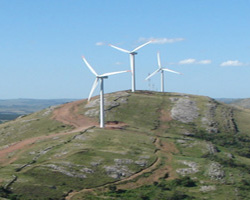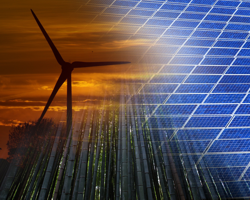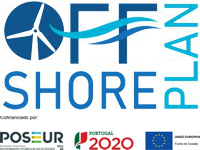Download Information About Energy Resources
Service that allows you to download free of charge various information about Energy Resources.

Potencial Renewable Energy Acceleration Areas (RAAs)
Year : 2024
This work was carried out by the GTAER - Working Group for the Definition of Renewable Energy Acceleration Areas, created by Order no. 11912/2023 of 23 November, and is intended to consolidate and strengthen the previous work carried out to identify the areas with the least sensitivity for the location of renewable electricity production units (solar photovoltaic and wind). The work assessed the potential for implementing generation units in natural areas or territories, artificialized surfaces and reservoirs. This work also proposes appropriate rules for implementing renewable energy projects and the applicable mitigation measures. The process of identifying PRAAs took into account 5 different scenarios, depending on whether or not the following constraints were excluded: (i) areas relating to aquifers classified as porous or essentially porous, belonging to the western edge and the Tejo-Sado basin; (ii) areas relating to the distance between residential and mixed-use built-up areas and (iii) available RAN (National Agricultural Reserve) and REN (National Ecological Reserve) areas. The areas presented will be favoured areas from the point of view of simplifying the licensing process, but they are not exclusive, and renewable energy units can be implemented in the rest of the territory in accordance with the normal licensing process. The results presented reflect the situation as of February/March 2024.

Portuguese Atlas of Sustainable Green H2
Year : 2022
This Atlas is a tool based on georeferenced information that follows criteria defined in the construction of scenarios to assess the suitability of the location of green hydrogen production projects regarding: (i) resources needed to power the hydrogen production processes by water electrolysis; (ii) land use constraints for the implementation of the green hydrogen production units, and (iii) factors that enhance the commercialization of the produced hydrogen. You can download the maps referring to 4 scenarios are presented: A - Diversified, B - Drought + Gas and Transport Network; C - Drought + gas consumers; D - Prospective.

Atlas of Wind Potential of Continental Portugal
Year : 2019
The Atlas of Wind Potential of Mainland Portugal illustrates, for the various regions of the country, the energy resource of wind and the consequent estimates of wind production, as well as other relevant statistical parameters. Thus, it is a powerful preliminary tool, not only for the prior assessment of the wind potential, but also as an auxiliary instrument for deciding future investments in experimental campaigns for wind characterization and planning of electricity grids and other infrastructures.

Less sensitive areas with a view to the potential installation of solar and wind electricity generation units (version June 2023)
Year : 2023
The maps identify areas of mainland Portugal with less sensitivity (environmental, heritage and others) and which, as such, may be considered in the definition of future renewable "Go-To Areas" within the framework of the revision of the RED Directive. In these areas, since they are not covered by exclusion constraints regarding the preservation of environmental and heritage values (among others), a simplified permitting process for renewable power plants (solar photovoltaic and wind) may be implemented, thus accelerating its deployment without compromising other environmental and territorial values. The areas here mapped are preferred areas from the point of view of simplifying the permitting process, but they are not exclusive. In other words, renewable power plants can be deployed in other locations following the normal permitting process.

OffshorePlan Project – Planning the Instalation of Offshore Renewable Energy systems in Portugal
Year : 2019
This project aims to promote the implementation of systems to exploit offshore renewable energies on the Portuguese Coast. To achieve this, three main objectives were set: Obj1: To identify the renewable energy resources (var-RES)in the Portuguese Coast (offshore wind and waves -mapping and corresponding validation); Obj2: Impact of offshorevar-RES generation in the national electricity system (2035); Estimation of the temporal evolution of the reception capacity of the national electric grid for the production from offshore renewable sources (2035); Identification of the optimal participation of offshore wind generation in a (100%) renewable (2035) power generation system,and; Obj3:Technical, economic and social analysis of the use of energy at sea (hierarchy of renewable energy technologies at offshore regionsthrough its LCOE; Socio-economic and value chain analysis).

LocalEnergy Project
Year : 2019
The energy transition to decarbonised energy systems implies a continuous innovation in materials and in low-carbon energy technologies. LocalEnergy is in line with this strategy by addressing the development and exploitation of environmental-friendly and scalable low-cost technologies related to energy conversion. The main goal of LocalEnergy is the valorisation of endogenous resources (solar and mineral) through the development of energy-harvesting applications based on the tetrahedrite mineral, which offers a high exploitation potential: Portugal has a high level of solar energy irradiation (Fig. 1) and has one of the most important volcanogenic massive sulphide districts in the world, the Iberian Pyrite Belt, where tetrahedrite mineral series is one of the constituents (Fig. 2). Tetrahedrite is a class of copper antimony sulfosalt mineral (Cu12-xMxSb4S13, x less or equal to 2), i.e., consisting of earth-abundant and relatively non-toxic elements, thus opening new opportunities for renewable energy applications. LocalEnergy is focused on the material research and development for thermoelectric (TE) and solar energy harvesting.